Serving 426 students in grades Kindergarten-5, Upper Lake Elementary School ranks in the bottom 50% of all schools in California for overall test scores (math proficiency is top 50%, and reading proficiency is top 50%).
The percentage of students achieving proficiency in math is 25-29% (which is lower than the California state average of 33%). The percentage of students achieving proficiency in reading/language arts is 25-29% (which is lower than the California state average of 47%).
The student:teacher ratio of 19:1 is lower than the California state level of 21:1.
Minority enrollment is 53% of the student body (majority Hispanic), which is lower than the California state average of 80% (majority Hispanic).
Quick Stats (2025)
- Grades: Kindergarten-5
- Enrollment: 426 students
- Student:Teacher Ratio: 19:1
- Minority Enrollment: 53%
- Overall Testing Rank: Bottom 50% in CA
- Math Proficiency: 25-29% (Top 50%)
- Reading Proficiency: 25-29% (Btm 50%)
- Science Proficiency: 10-14% (Btm 50%)
- Source: National Center for Education Statistics (NCES), CA Dept. of Education
School Overview
Upper Lake Elementary School's student population of 426 students has grown by 20% over five school years.
The teacher population of 22 teachers has grown by 15% over five school years.
Grades Offered
Grades Kindergarten-5
Total Students
426 students
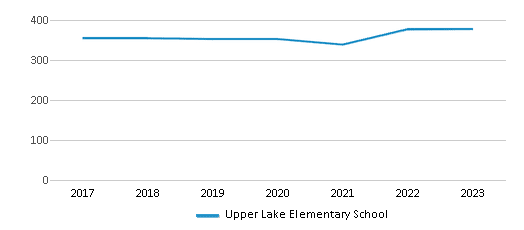
Gender %
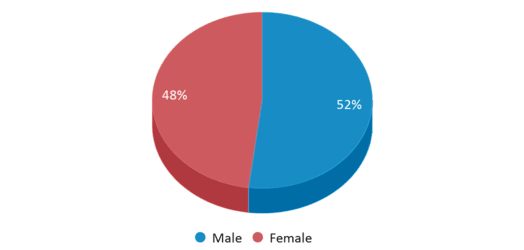
Total Classroom Teachers
22 teachers
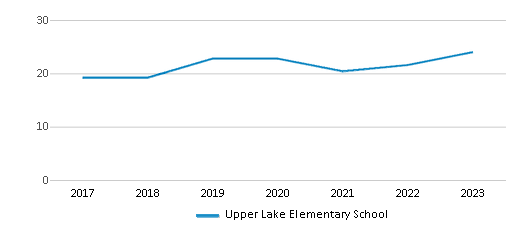
Students by Grade

School Rankings
Upper Lake Elementary School ranks within the bottom 50% of all 9,602 schools in California (based off of combined math and reading proficiency testing data).
The diversity score of Upper Lake Elementary School is 0.67, which is more than the diversity score at state average of 0.63. The school's diversity has stayed relatively flat over five school years.
Overall Testing Rank
#6171 out of 9602 schools
(Bottom 50%)
(Bottom 50%)
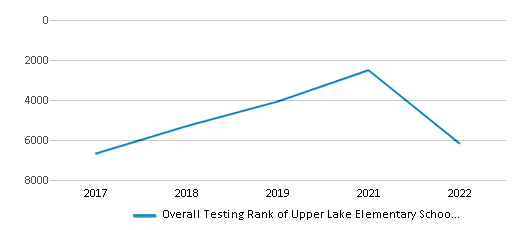
Math Test Scores (% Proficient)
25-29%
33%
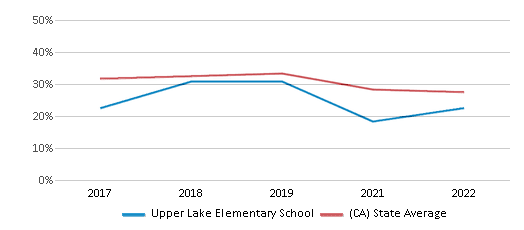
Reading/Language Arts Test Scores (% Proficient)
25-29%
47%

Science Test Scores (% Proficient)
10-14%
29%

Student : Teacher Ratio
19:1
21:1
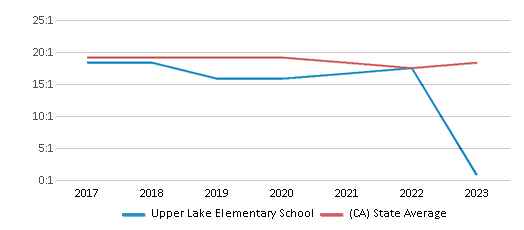
American Indian
10%
1%
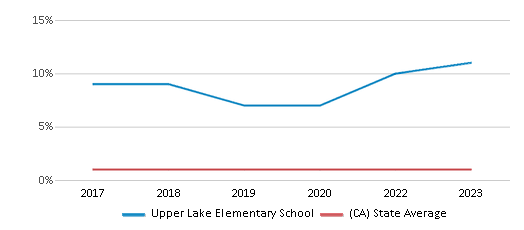
Asian
1%
12%
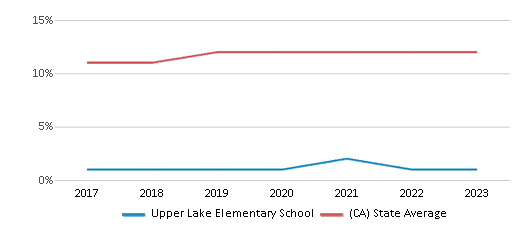
Hispanic
32%
56%
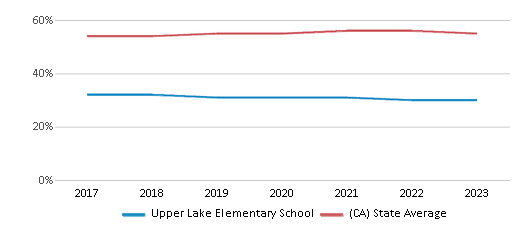
Black
1%
5%
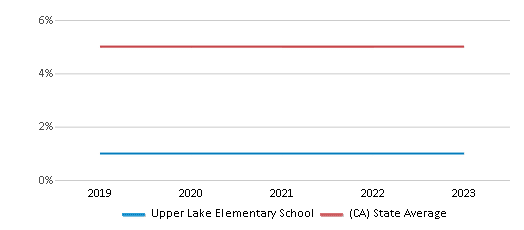
White
47%
20%
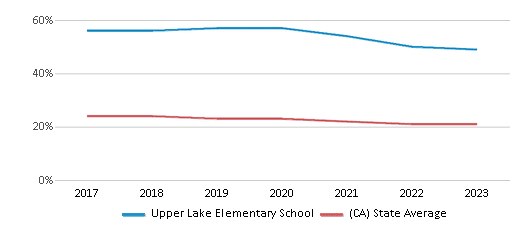
Hawaiian
n/a
n/a
Two or more races
9%
6%
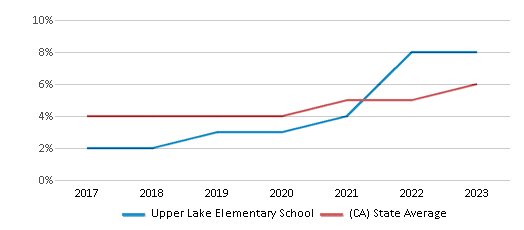
All Ethnic Groups
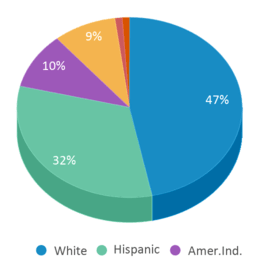
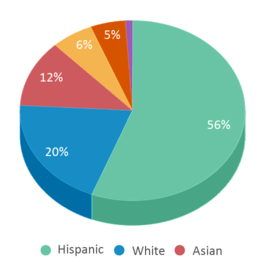
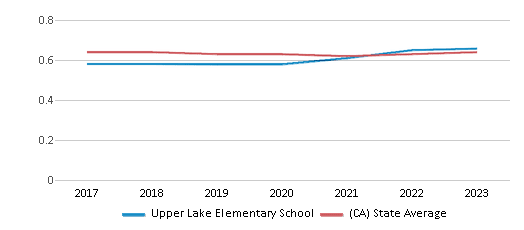
Eligible for Free Lunch
74%
54%
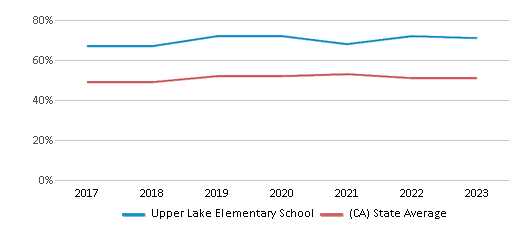
Eligible for Reduced Lunch
10%
8%
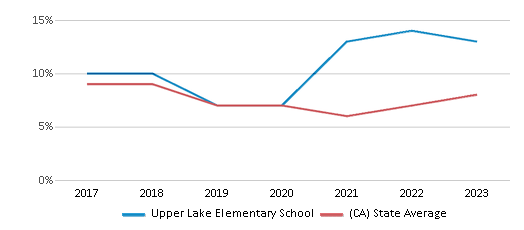
School Statewide Testing
School District Name
Source: National Center for Education Statistics (NCES), CA Dept. of Education
Profile last updated: 02/09/2025
Frequently Asked Questions
What is Upper Lake Elementary School's ranking?
Upper Lake Elementary School is ranked #6171 out of 9,602 schools, which ranks it among the bottom 50% of public schools in California.
What percent of students have achieved state testing proficiency in math and reading?
25-29% of students have achieved math proficiency (compared to the 33% CA state average), while 25-29% of students have achieved reading proficiency (compared to the 47% CA state average).
How many students attend Upper Lake Elementary School?
426 students attend Upper Lake Elementary School.
What is the racial composition of the student body?
47% of Upper Lake Elementary School students are White, 32% of students are Hispanic, 10% of students are American Indian, 9% of students are Two or more races, 1% of students are Asian, and 1% of students are Black.
What is the student:teacher ratio of Upper Lake Elementary School?
Upper Lake Elementary School has a student ration of 19:1, which is lower than the California state average of 21:1.
What grades does Upper Lake Elementary School offer ?
Upper Lake Elementary School offers enrollment in grades Kindergarten-5
What school district is Upper Lake Elementary School part of?
Upper Lake Elementary School is part of Upper Lake Unified School District.
School Calendar
View the Upper Lake Elementary School yearly calendar below. Note key dates such as:
Event
Date
LAST DAY OF SCHOOL!
June 05, 2025 (Thursday)
School Reviews
2 1/29/2020
The teachers seem caring and committed, but the school does not have the personnel or funding needed to create a well-rounded experience for all children to succeed. Children who need speech therapy or aides due to learning challenges or special needs do not have them. Children who need step-by-step instruction are overlooked, not because of a lack of empathy but because one teacher to twenty-two students can not attend to each student's special needs. No speech therapy is offered on campus at this time to my knowledge.
2 10/27/2014
My child has special needs and fell and got seriously hurt at the school during school time, this was not properly dealt with, not enough safety procedures and due to health issues a more modified day is needed, but not given. This school is not equipped or safe for children who have special needs.
2 10/5/2010
The administrators are incompetent and unprofessional. Being a small, rural school district, there are a lot of cut corners in providing services to special education students. There is a lack of knowledge of state/fed laws, or perhaps a lack of caring. There are some very good and dedicated regular education teachers, despite the lack of good leadership.
Review Upper Lake Elementary School. Reviews should be a few sentences in length. Please include any comments on:
- Quality of academic programs, teachers, and facilities
- Availability of music, art, sports and other extracurricular activities
Recent Articles
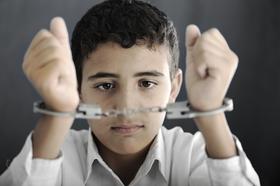
School-to-Prison Pipeline Persists Despite Local, State and National Efforts
Inadequate funding and resources for schools, harsh zero-tolerance discipline policies, police presence in public schools, and de facto segregation continue to create school environments in which poor and minority students have little chance of succeeding. The result is a continuation of the school-to-prison pipeline that has been commonplace in the American education system for decades, despite federal, state and local efforts to curb the problem.

How the Arts Benefit Your Children Academically and Behaviorally
Often underfunded in the past, the arts are gaining a resurgence in support as research shows benefits for children academically, along with improvements in behavior and attendance.

February 05, 2025
Understanding the U.S. Department of Education: Structure, Impact, and EvolutionWe explore how the Department of Education shapes American education, from its cabinet-level leadership to its impact on millions of students, written for general audiences seeking clarity on this vital institution.






